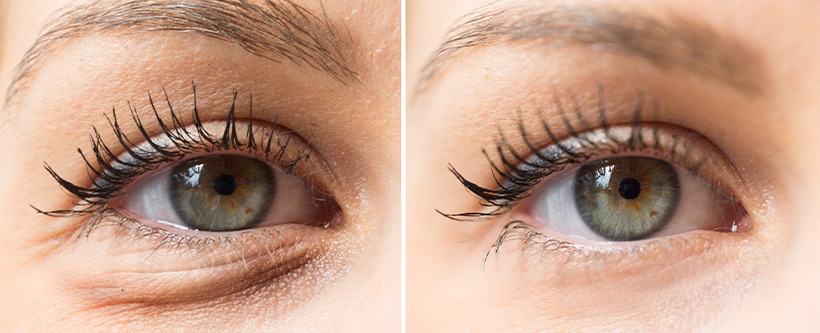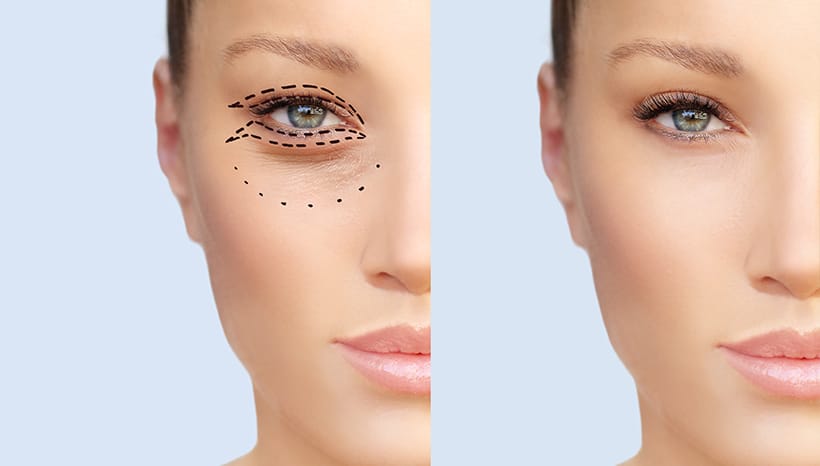Virginia, Washington D.C. and Maryland.
(In Office Surgical Facility)
Post-Operative Instructions for Blepharoplasty
Night Of Blepharoplasty Surgery
- Ice Compresses: Apply ice compresses made of gauze sponges that are dipped into iced water (not an ice bag) to your eyes for 15-20 minutes every hour for the first two days while you are awake.
- Head Elevation: Sleep on your back with your head elevated about 30-40 degrees (2-3 pillows). Do not sleep on your side. Keeping your head elevated will minimize swelling. Continue this for one week.
Nutrition After Blepharoplasty
- Diet: A light low-fat diet is best after surgery. You may start a regular diet after your surgery if you are not feeling nauseous or vomiting.
- Hydration: Stay hydrated by drinking 8 -10 glasses of water a day. Avoid alcohol for 48 hours and while you are taking pain medications.
Medications For Blepharoplasty
- Antibiotic: Start your antibiotic tablet 24 hours prior to surgery. Take all tablets as prescribed and until finished.
- Pain Medication: You will be prescribed a pain medication for post-operative pain control. If your discomfort after surgery is not strong you are welcomed to take Tylenol in place of the prescribed medication. Do not take Tylenol with the pain medication, often the medication you are prescribed will have Tylenol in it. Do not exceed 4,000 mg of Tylenol in any 24-hour period. Take medication with food to minimize risk of nausea.
- Eye Ointment: Apply 3 times a day Ophthalmic Bacitracin Eye Ointment to cover any visible incisions for 5 days.
- Constipation: Sometimes decreased physical activity as well as pain medications may lead to constipation. Any over the counter stool softener such as Metamucil or Colace can be used.
- Nausea: Some pain medication may make you feel nauseous. It is best to eat something small 20 minutes before taking pain medication. Keep hydrated with small sips of non-caffeinated beverages (Ginger Ale, Sprite, Gatorade).
- Medications to Avoid: Avoid medications containing aspirin or ibuprofen (Advil, Motrin, Ibuprofen, and others) for two weeks before and after surgery. These medications may increase bleeding.
- Substances to Avoid: Avoid alcohol, nicotine, and caffeine, for these will dramatically slow the healing process.
Bathing After Blepharoplasty
- You may wash your hair and face the next day after your eyelid surgery. Do not cleanse eye area and avoid submerging your face in water.
- Hot Tubs/Baths/Swimming Pool: No tub baths or jacuzzi until your incisions have healed, and approved by your surgeon, which is usually around 6 weeks.


How To Take Care Of Your Incisions After Blepharoplasty
- Cleaning your incisions: Occasionally, crusting will occur around the sutures. This is normal and will resolve. You can gently clean your incision with hydrogen peroxide on a cotton swab if this occurs. Do not try to pull off any crusts. Showering daily will minimize crusting. Apply your bacitracin ophthalmic ointment to keep incision sites moist.
- Sun Exposure: Avoid and minimize sun exposure. Even a mild sunburn can worsen swelling and irritate an incision that is healing.
- Scar gel: After your incisions have completely healed and when your doctor has told you it is safe, you can begin to use silicon-based gel on your scars to improve healing.
What To Expect After Blepharoplasty
- Swelling and Discoloration: It is completely normal for your eyes to appear swollen as well as have purple-bluish bruising around the eye and eyelid. The bruising will be greater on the second and third day after your surgery. This is temporary and over the course of the next six weeks this will improve. Cool compresses will minimize swelling and bruising.
- Mild Bleeding: Some mild bleeding is not unusual at the incision sites the first few days after surgery. If you try to do strenuous activity, increase your blood pressure by straining on the toilet, sneezing, heavy lifting or bending forward you will aggravate the bleeding and swelling.
- Numbness around the eyes: Parts of the eyelids may feel “numb” or lumpy after the eyelid operation. This is temporary and to be expected and may take months to feel normal again.
- Pain and Itching: You may experience some sharp shooting pain or itching during the healing process normal and will resolve in a few weeks.
- Blurry Vision: Patients often experience some blurring of vision for 2-3 days after surgery. This is generally due to swelling and/or ointments that have been used during surgery.
- Sutures: At your first post-op office visit your sutures will be removed and the progress of your healing will be assessed. Sutures are usually removed 5-7 days after your procedure. Subsequent office visits for 1 year are important in order to monitor proper healing.
- Weak or Dizzy: You may experience some weakness or dizziness. This may be more evident if you try to stand up too quickly. Take a minute to go from lying down to standing. The sensation of feeling lightheaded will get better in a few days and by staying well hydrated.
- Scars: After all stitches have been removed, the scars will appear a deep pink color. With time, the pink will fade and become white, the firmness of the scar will soften, and they will become less noticeable. Each individual varies with respect to healing, but it takes approximately a year for these changes to occur and the scars to look their best. Once your surgeon advises you, you may apply a silicon-based scar gel to your scar for enhanced healing.
- Final Result: Expect to see your result at one year as the healing process takes time.
Activity After Blepharoplasty
- Movement is Important: Make sure you are up and walking around immediately after your surgery. When lying down in bed or on the couch, make sure you are moving your legs and ankles.
- Glasses: You may wear sunglasses and eyeglasses the day after surgery.
- Limit Strain on the Eyes: The less TV, computers, phones, and other screen devices the less strain on your eyes and better your healing and recovery.
- Driving: Do NOT operate a vehicle or make important decisions until you have been off pain medications for 24 hours. Use good judgment.
- Return to work: Most patients require approximately 5-7days off work depending on their job responsibilities. Depending on the amount of physical contact your job involves and the amount of swelling and discoloration you develop, you can decide when you are ready to be in the public eye.
- Exercise: Normal activity can be resumed a few days after surgery. You can resume an exercise regimen in approximately 3 weeks after surgery, though start easy and build back up to your previous exercise levels. Just know that swelling may transiently be worse with exercise.
- Travel: Automobile travel can resume immediately though frequent breaks are needed, approximately every 2 hours to prevent blood pooling and clots. Airline travel is restricted until 1 week postop. You will notice increased swelling with airline travel which can happen even 6-8 weeks postop due to the pressure changes that occur. Do not drive if you are taking narcotic pain medications.
Do Not’s After Blepharoplasty
- DO NOT place anything frozen directly on the skin.
- DO NOT submerge your face in water or get your eyelid incisions wet while the incisions are still healing.
- DO NOT take Aspirin, Ibuprofen, Naproxen, or other blood thinners until your surgeon advises you it is safe.
- DO NOT apply make-up to the incision lines or the eyelids for one month.
- DO NOT wear fake eyelashes or contact lenses for two weeks.
Emergency Situations After Blepharoplasty
WHEN TO CALL THE OFFICE (703-481-0002) OR GO TO THE HOSPITAL
- Signs of Infection: Spreading of redness, worsening of swelling, increased drainage or drainage of pus, worsening pain, warmth at incision site and temperature over 101°F.
- Excessive Bleeding: If the dressings are saturated with bright red blood and you are having to make very frequent dressing changes or if the incision sites appear to be oozing blood excessively.
- Other Emergency Situations: Shortness of breath or difficulty breathing, chest pain, lightheadedness that does not quickly resolve, severe vomiting, pain, or asymmetric swelling in your legs.